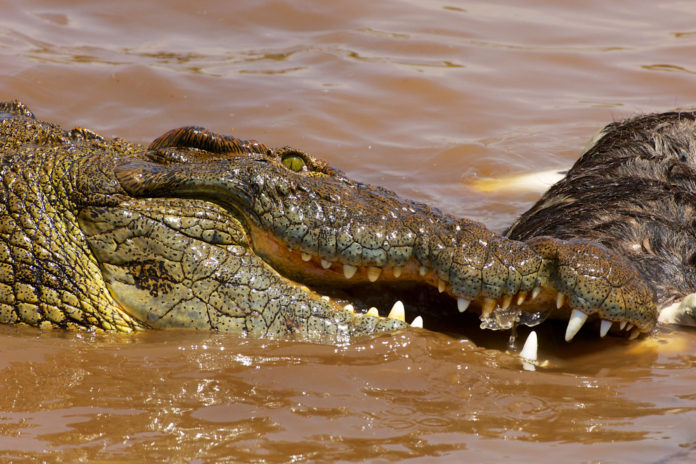By Kizito Makoye & Zuberi Mussa
Rorya, Tanzania — At Koryo village, in Tanzania’s northern Rorya district brightly dressed women flock to the river with piles of their laundry bags.
Some of them walk for hours just to be on time to access an increasingly endangered resource: water.
Nestled on the Tanzanian border with Kenya, the village receives enough rainfall, but for some reason, the water doesn’t meet the growing needs of the inhabitants.
“We have lost six permanent rivers in the past two decades,” says 57-year-old Andrew Nyamaka a local resident, adding “When the dry season sets in finding water is a constant struggle.”
Endangered Livelihoods
Depleting water resources in this impoverished village highlight the worsening plights of people in the wider Mara basin whose lives are increasingly endangered.

The livelihoods of 1.1 million people in Kenya and Tanzania are on the brink as fish are driven to extinction, according to WWF.
A new report by the wildlife NGO says the trans-boundary river is threatened by among others, unsustainable farming, deforestation, mining, illegal fishing, and invasive species.
The report, which examined freshwater biodiversity in the river basin identified 473 native freshwater species including four mammals, 88 water birds, 126 freshwater associated birds, four reptiles, 20 amphibians, 40 fishes, 50 invertebrate species, and 141 vascular plants.
According to the report, some fish species including; Niangua, Singed and Victoria tilapia are critically endangered and increasingly threatened by the Nile perch that had been introduced in Lake Victoria.
Birds Too At Risk
The report also listed some bird and fish species including Madagascar pond-heron, grey crowned crane, and killifish as endangered whereas the shoebill, and some crab and freshwater mussel species, are described as vulnerable.
Amani Ngusaru, country director, WWF Tanzania said the river is under huge pressure from destructive human activities such as unsustainable agriculture, tourist facilities, water pollution, and land degradation.

“Several aquatic species have not been seen for many years and may be extinct before they have been studied,” he said in the report.
His remarks were echoed by Yunus Mgaya, professor of Marine Biology at the University of Dar es Salaam, who concurs with the report saying that the farming and irrigation activities have seriously affected the river flow and ecological balance of the basin.
“The basin is facing a bleak future that put the river at risk, unless deliberate efforts are taken to reverse this trend many livelihoods will suffer,” he told the Ubuntu Times.
As the world is grappling with rapid decline of freshwater biodiversity due to the changing weather patterns, WWF is calling for joint efforts to preserve critically endangered freshwater biodiversity.
Tourist Attraction
The Mara basin, which sprawls across 13,750 sq km is home to many plant and animal species. Known for its great spectacle of wildebeest and zebra migration, the area attracts tourists who inject millions of dollars in Kenya and Tanzania economies.

Tourism plays a pivotal role in the economies of both countries. The sector provides direct employment to thousands of people and contributes roughly US$1 billion to the economies of Kenya and Tanzania.
The Maasai Mara National Park, for instance, attracts more than 300,000 visitors every year, bringing roughly Kenyan Shillings 650 million, or 8 percent of the country’s total tourism earnings.
Water Abstraction
As the only water source in the dry season, the Mara River, which runs through Maasai Mara Game Reserve in Kenya and the Serengeti National Park in Tanzania, has experienced erratic flow, partly due to the abstraction of water for irrigation and hydropower.
The basin and its adjoining wetland is under increasing strain due to farming, overgrazing and irrigation activities, which have affected the quality of water and the flow of the river.
Fishing and agriculture are the main economic activities and sources of livelihood for many people in the Mara basin. More than 80% of the population in communities around the swamp are engaging in farming and fishing.
Local residents both in Kenya and Tanzania rely on fish and other aquatic foods harvested in ponds, lakes, and rivers to get healthy diets for their families and livelihoods.
Rose Kasoka, a 44-year-old fish vendor travels far to buy a stock of dried fish to sell at retail price.
“I don’t realize much profit because I don’t often get Ningu which most customers love,” she said.
Reversing Deforestation
In the village of Ikoma, Waridi Mwita, a 51-year-old farmer, is busy packing soil into plastic seedling bags. She’s trying to plant trees in the hope to restore forest cover that has long been destroyed.
“People are very busy making charcoal, they don’t realize they are destroying the environment and are preparing for their own extinction,” Mwita told the Ubuntu Times.
Deforestation especially in the Mau Forest and dry-season soil erosion have exacerbated the effects of drought as the water level drops to its lowest ebb, consequently affecting humans and wildlife.
Indigenous forests have been logged for timber and charcoal burning.
“One of the reasons trees are cut down is to produce charcoal, which is a lucrative business in these communities,” Mwita said.
In this tiny village, perched on groves of banana trees, water was once plentiful. But due to spells of drought, most small rivers have dried out.

“When I was young, my parents never experienced water problems that we experience today,” she said.
According to WWF report, the quality of water in the Mara River is also affected by domestic waste whose disposal has negatively affected aquatic life by reducing fish spawning sites and even clog their gills.
“Heavy metal contamination from mining activities is posing a huge risk to ecology and people,” the report warned.

